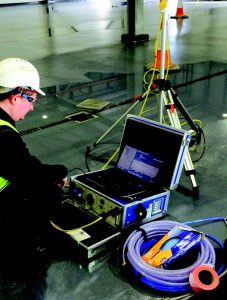How can we help? Let’s talk about Hydrostatic Testing.
In high-risk industries, ensuring that the system and equipment operate safely and reliably is a major priority. Hydrostatic testing can help identify any leaks, weaknesses, or other issues.
This service is particularily relevant for Pharmaceutical, Food and Manufacturing, Construction and Local Authorities Sectors.
Hydrostatic testing is critical for maintaining the safety and dependability of piping systems, minimizing the risk of accidents, environmental harm, or expensive downtime by ensuring that the system can withstand the pressures it will encounter during operation.
For some industries it is a requirement as part of their EPA licence to test to DIN EN 1610 which is the European standard for the installation and testing of wastewater pipelines, sewers and manholes in drainage systems.
What does this involve?
- Preparation
Before testing, the piping system needs to be cleaned and drained to eliminate any residue that could affect the test results. Additionally, connections such as valves and flanges are inspected to ensure they are installed correctly and firmly.
- Filling
The system is then filled with clean and contaminant-free test fluid such as water until it is completely full.
- Pressurizing
The system is gradually pressurized and monitored using pressure gauges until it reaches a predetermined level. This pressure is maintained for a specific duration, typically 10 minutes.
- Inspection
While the system is pressurized, it undergoes a visual inspection and other testing methods like ultrasonic testing to identify any leaks or failures. Any leaks or failures detected must be repaired before the system is put into service.
- Depressurizing
Following the completion of the test, the system is depressurized slowly and drained of the test fluid. The system is then dried and prepared for operation.
What Are The Benefits of Hydrostatic Testing?
- Safety: Hydrostatic testing can ensure safety by detecting any weaknesses or defects in the equipment that could potentially lead to accidents. By detecting and repairing these issues, hydrostatic testing can prevent equipment failures which helps ensure the safety of the people and the environment.
- Avoiding significant damage: The test can also detect leaks as it is an effective way to detect leaks in piping systems. By pressurizing the system with water, leaks can be easily identified and repaired before they cause significant damage or loss.
- Regulation requirements: Companies using hydrostatic testing on their piping systems directly demonstrate that they are following the required safety regulations and industry standards. They also take appropriate measures to ensure the safety of their equipment and the people working with it. This can help prevent accidents, injuries, and property damage while equipment is functioning as intended.
- Compliance requirements: The hydrostatic testing requirements are intended to verify the strength, pressure-bearing capacity, and leak-tightness of piping systems, ensuring their safety and compliance with code requirements.
- Improving reliability: Hydrostatic testing is an important process for improving the reliability of pressure vessels, pipelines, and other components, by identifying and addressing any potential issues that could cause system failure or downtime.
These processes require specialized knowledge, equipment and skills to perform safely and accurately.
A basic requirement is up-to-date software along with trained engineers, and upon completion, a comprehensive report on the integrity of your pipes and bunds.
What do you do if you get a FAIL results?
If a hydrostatic test is a FAIL, CD Environmental offer several options in order to fix pipes while minimising disruption and loss of time to your business.
CD Environmental are busy providing this service weekly nationwide – get in touch if you’d like a quote.

